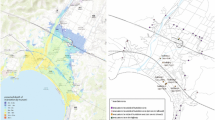Abstract
Evacuation planning crucially depends on good routing strategies. This article compares two different routing strategies in a multi-agent simulation of a large real-world evacuation scenario. The first approach approximates a Nash equilibrium, where every evacuee adopts an individually optimal routing strategy regardless of what this solution imposes on others. The second approach approximately minimizes the total travel time in the system, which requires to enforce cooperative behavior of the evacuees. Both approaches are analyzed in terms of the global evacuation dynamics and on a detailed geographic level.
Preview
Unable to display preview. Download preview PDF.
Similar content being viewed by others
References
Ben-Akiva, M., Lerman, S.R.: Discrete choice analysis. The MIT Press, Cambridge (1985)
Bierlaire, M., Antonini, G., Weber, M.: Behavioral dynamics for pedestrians. In: Axhausen, K. (ed.) Moving through nets: The physical and social dimensions of travel. Elsevier, Amsterdam (2003)
Chen, X., Zhan, F.: Agent-based modeling and simulation of urban evacuation: Relative effectiveness of simultaneous and staged evacuation strategies. Paper 04-0329, Transportation Research Board Annual Meeting, Washington, D.C (2004)
Ferber, J.: Multi-agent systems. An Introduction to distributed artificial intelligence. Addison-Wesley, Reading (1999)
Gawron, C.: An iterative algorithm to determine the dynamic user equilibrium in a traffic simulation model. International Journal of Modern Physics C 9(3), 393–407 (1998)
Helbing, D., Farkas, I., Molnar, P., et al.: Simulation of pedestrian crowds in normal and evacuation situations. In: Proceedings of the 1st international conference on Pedestrian and Evacation Dynamics, 2001, Duisburg. Springer, Heidelberg (2002)
Hobeika, A., Kim, C.: Comparison of traffic assignments in evacuation modeling. IEEE Transactions on Engineering Management 45(2), 192–198 (1998)
Jha, M., Moore, K., Pashaie, B.: Emergency evacuation planning with microscopic traffic simulation. Paper 04-2414, Transportation Research Board Annual Meeting, Washington, D.C (2004)
Klüpfel, H., Meyer-König, T., Keßel, A., et al.: Simulating evacuation processes and comparison to empirical results. In: Fukui, M., et al. (eds.) Traffic and granular flow 2001, pp. 449–454. Springer, Heidelberg (2003)
Kwon, E., Pitt, S.: Evaluation of emergency evacuation strategies for downtown event traffic using a dynamic network model. Paper 05-2164, Transportation Research Board Annual Meeting, Washington, D.C (2005)
Lämmel, G., Grether, D., Nagel, K.: The representation and implementation of time-dependent inundation in large-scale microscopic evacuation simulations. Transportation Research Part C: Emerging Technologies. Corrected Proof: (in Press, 2009)
Lämmel, G., Rieser, M., Nagel, K., et al.: Emergency preparedness in the case of a tsunami – evacuation analysis and traffic optimization for the Indonesian city of Padang. In: Proceedings of the 4th international conference on Pedestrian and Evacuation Dynamics, 2008, Wuppertal. Springer, Heidelberg (2009)
Lu, Q., George, B., Shekhar, S.: Capacity constrained routing algorithms for evacuation planning: A summary of results. In: Bauzer Medeiros, C., Egenhofer, M.J., Bertino, E. (eds.) SSTD 2005. LNCS, vol. 3633, pp. 291–307. Springer, Heidelberg (2005)
Nash, J.: Non-cooperative games. Annals of Mathematics 54(2), 286–295 (1951)
Peeta, S., Mahmassani, H.: System optimal and user equilibrium time-dependent traffic assignment in congested networks. Annals of Operations Research 60, 81–113 (1995)
Peeta, S., Ziliaskopoulos, A.: Foundations of Dynamic Traffic Assignment: The Past, the Present and the Future. Networks and Spatial Economics 1(3), 233–265 (2001)
Schneider, V., Könnecke, R.: Simulating evacuation processes with ASERI. In: Proceedings of the 1st international conference on Pedestrian and Evacation Dynamics, 2001, Duisburg. Springer, Heidelberg (2002)
Sheffi, Y.: Urban Transportation Networks: Equilibrium Analysis with Mathematical Programming Methods. Prentice-Hall, Englewood Cliffs (1985)
Author information
Authors and Affiliations
Editor information
Editors and Affiliations
Rights and permissions
Copyright information
© 2009 Springer-Verlag Berlin Heidelberg
About this paper
Cite this paper
Lämmel, G., Flötteröd, G. (2009). Towards System Optimum: Finding Optimal Routing Strategies in Time-Dependent Networks for Large-Scale Evacuation Problems. In: Mertsching, B., Hund, M., Aziz, Z. (eds) KI 2009: Advances in Artificial Intelligence. KI 2009. Lecture Notes in Computer Science(), vol 5803. Springer, Berlin, Heidelberg. https://doi.org/10.1007/978-3-642-04617-9_67
Download citation
DOI: https://doi.org/10.1007/978-3-642-04617-9_67
Publisher Name: Springer, Berlin, Heidelberg
Print ISBN: 978-3-642-04616-2
Online ISBN: 978-3-642-04617-9
eBook Packages: Computer ScienceComputer Science (R0)




